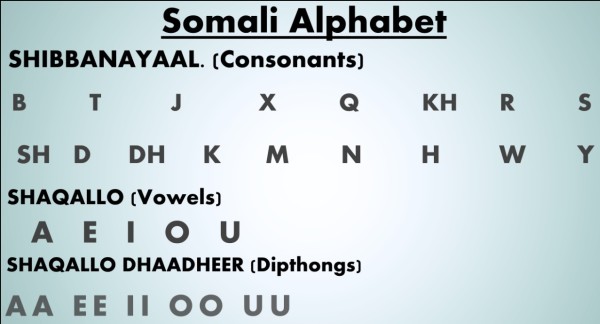Key milestones in the history of Somali language

In October 1972 the Somali script, based on the Somali Latin alphabet, was standardised and introduced as the Official Somali Language Script. Somali, which had been until then an oral language, could now be transmitted and preserved in textual form.
Somali is the national language of Somalia. It is also spoken in Djibouti, Ethiopia, and Kenya, as well as by Somali communities in diaspora.
This anniversary comes a time the most comprehensive Somali dictionary is available at the markets, regional academy dedicated to study and preserve Somali language is active.
Hundred of Somali language websites, and television stations, radios, and newspapers use Somali language on a daily basis.
Former Somali military government had heavily invested in culture and language and used songs and plays to deliver nationalist messages. The government employed talented poets and playwrights. It was the golden age of the Somalia language.
Today after long period of drought Somalia is gradually revisiting this idea of preserving and promoting the Somali language especially among the younger generation.
President Hassan Sheikh Mohamud and his Djibouti counterpart Ismael Omar Gelleh last year laid the foundation stone for the Somali Language and Research Academy. Today the two leaders are meeting in Mogadishu to review the year’s developments.
Here are some of the notable developments in the history of Somali language.
1920: In the early 1920s, Osman Yusuf Kenadid in response to settle on a standard orthography for the Somali language devised a phonetically sophisticated alphabet called Osmaniya for representing the sounds of Somali.
July 1, 1961: Months after independence Somali, the government tasked established academics and Somali writers to devise ways on setting up a standard Somali language script for writing. The commission did fail to accomplish the assigned mission because of dispute on which language alphabet system to be adopted, Latin or Arabic.
The following people were appointed to the commission:
- Muuse Haaji Ismail Galaal-Chairperson
- Yaasiin Osmaan Yuusuf – member
- Mahamuud Saaleh (Ladane)- member
- Ibraahim Haashi Mahamuud – member
- Khaliif Suudi- member
- Mustaf Sheikh Xasan- member
- Shire Jaamac Ahmed- member
- Husein Sheikh Ahmed (Kaddare)- member
- Yuusuf Maygaag Samatar- secretary
October 21, 1969: The head of the Supreme Revolutionary Council who was now president, Siad Barre revived the idea of writing the Somali language script.
21 January 1971: Somali military government formed a new commission. This time 21 language experts and academics were assigned to adopt a standard orthography for Somali language and in October 1972 the Somali script, based on the Somali Latin alphabet, was standardised and introduced as the Official Somali Language Script.
The following persons were tasked with the responsibility:
- Sharif Salah Mohamed Ali- Chaiperson
- Yaasin Omaan Keenadiid
- Mustaf Sheikh Hasan
- Ahmed Ali Abokar
- Yuusuf Hirsi Ahmed
- Msuse Haaji Ismail Galaal
- Abdidaahir Affey,
- Aw Jaamac Omar Iise
- Dahabo Faarah Hasan
- Abdulaahi Haaji Abuubakar
- Abdullaahi Ardeeye
- Hasan Sheikh Muumin
- Mahamed Nuur Alin
- Mahamed Hasan Aaden (Gaheyr)
- Hirsi Magan Iise
- Omar Aw Nuuh
- Abdullaahi Haaji Mahamuud (Insaaniya)
- Iikar Bannaa Hadaad
- Aaqib Abdullaahi
- Husein Sheikh Ahmed Kadare
- Ahmed Artan Haange
- Mohamed Haaji Husein Sheeko Hariir
- Abdirahmaan Nuur Hersi
- Shire Jaamah
Twenty two (22) months after its formation, the commission successfully produced the first official Somali written script which would be adopted for to date. The script had 21 consonants and five vowels.
January 21, 1973: The first primary school curriculum in Somali language was launched. The first newspapers fully written in the new Somali script was also launched.
March 7, 1974: The government launched a mass literacy campaign targeting all the rural areas to ensure everyone learnt the written language. By the end of the campaign in early 1975, the literacy levels had significantly increased from 2% to 55%.
January 21, 2015: While marking the 42nd anniversary of the Somali script, President Mohamud ordered that all government communication will be conducted in Somali language. Italian language had been one of the official government language of communication.
February 21, 2015: Djibouti President Ismail Omar Gelle and Somali president Hassan Sheikh Mohamud together laid the foundation stone of Somali Language and Research Academy in Mogadishu.
January 2016: Banaadir mayor Yusuf Jima’ale orders that all advertising media in Mogadishu be published in Somali language, failure to which none shall be licensed.
January 21, 2016: Somalia and Djibouti presidents Hassan Sheikh Mohamud and Omar Gelle respectively meet to mark the second anniversary of the Language Academy.
By Abdi Aziz Gurbiye
Other articles by this author:
Today in History 1948: Somalia popular freedom fighter Hawa-tako killed
President Mohamud’s administration lost chance to capitalize on US recognition of Somali government